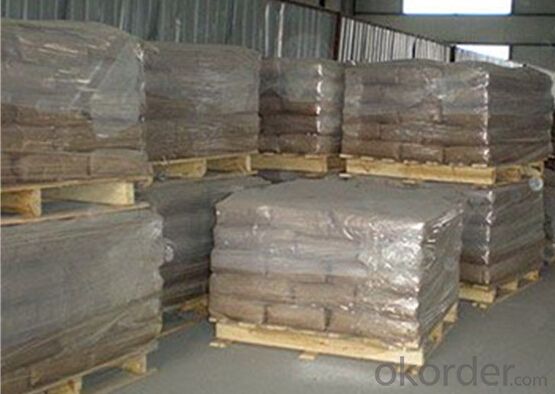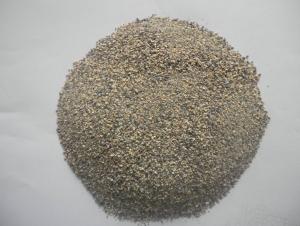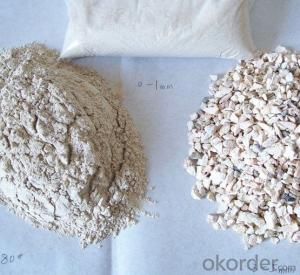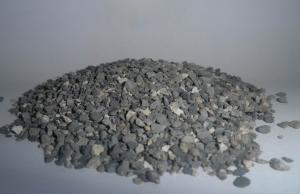Refractory Castable ASC-6 Used For Iron Runner Of Casthouse
- Loading Port:
- China Main Port
- Payment Terms:
- TT OR LC
- Min Order Qty:
- -
- Supply Capability:
- -
OKorder Service Pledge
OKorder Financial Service
You Might Also Like
Specifications
Excellent slag resistance and thermal shock performances, long service life, easy casting.
RAW MATERIALS:
Iron runner refractory castable , using premium quality fused alumina as main raw materials.
with added silicon carbide for maximum wear resistence and chemical attack resistance,.
Alumina clay, high alumina cement and superfine powder as bonding agents for easy and strong bonding.
PRODUCT FEATURES:
Allows for quick baking wiithout cracks or seldom cracks.
Excellent high temperature mechanical properties and resistance to slag erosion.
Exhibits excellent structure stability and highly resistant to spalling.
AREAS OF APPLICATION:
Applicable to the blast furnace molten iron runner, iron trough.
Also used on slag runners as working layer refractory castable.
SERVICE LIFE:
Under normal operating conditions, our product is capable of serving 150000 tons of molten iron or more. 170000 tons or more is possible for cleaner iron.
PRODUCT SPECIFICATIONS:
| Characteristics | Value | |
| Al2O3/% | ≥60 | |
| (SiC+C)/% | ≥10 | |
| Bulk density(g/cm³) | 110℃×24h | ≥2.70 |
| 1450℃×3h | ≥2.65 | |
| Linear changes on heating(%) | 1450℃×3h | ±0.5 |
| Cold compressive strength(Mpa) | 110℃×24h | ≥ 20 |
| 1450℃×3h | ≥ 40 | |
| Packaging Detail: | Packed in small bags or large jumbo bags which are fastened on pallets. Well insulated against moisture. |
FACTORY:


- Q: hat kind of fire retardant materials are there
- At present, there are mainly organic and inorganic flame retardant materials, halogen and non halogen. Organic flame retardant materials are represented by bromine, nitrogen and phosphorus and its compounds; Inorganic fire retardant materials include antimonous oxide, magnesium hydroxide, aluminum hydroxide, and silicon. Generally speaking, organic flame retardant materials have a good affinity, and can be added in the plastics. Brominated flame retardant agent occupy the absolute advantage among organic flame retardant system, though it’s “controversial” in terms of environmental protection, it has been difficult to have other flame retardant system replaced.
- Q: What is the principal part of silicious refractory material
- Silicon nitride and aluminite powder as well as dextrin
- Q: Do you know the refractories?
- Acidic material products: these products to quartz (SiO2) as the first phase, SiO2 is an acid oxide, helped named. Brick is representative of the product acid material; semisilica brick, alkali proof brick, acid brick in SiO2 content of 60% to 80%, is a semi acidic material.
- Q: How to distinguish the fire?rating of rubber and plastic thermal insulation material?
- According to GB 8624-2006 "building materials and combustion products classification", the division of the material's combustion performance grade is changed from five levels of level A (homogeneous material), A (composite sandwich material), B1, B2 and B3 to seven levels of A1 , A2, B, C, D, E and F or A1f1, A2f1, Bf1, Cf1, Df1, ef1 and Ff1 or A1L, A2L, BL, CL, DL, EL and FL . The level B1 rubber and plastic fireproof and thermal inuslation matertial is the best, but the most commonly used one is level B2. Hope it will help you.
- Q: Who knows about the fire endurance of sintered shaly hollow bricks?
- Sintered shaly hollow bricks of Chu area have high intensity. The average compressive strength of them is up to 15.8, which matches with M7.5 cement mortar that has advantages of low water absorption, and good anti efflorescence performance. The fire endurance of sintered shaly hollow bricks should not exceed1050 degrees otherwise they will burn excessively. I, actually, think that the temperature should be controlled within 980 degrees. I hope my answer may help you.
- Q: What is the acceptance standard of refractory?
- It depends on the variety of materials. In general the main test items include chemical composition, refractoriness, refractoriness under load, creep, volume density, linear change, strength, slag resistance, thermal conductivity and thermal expansion. If it is shaped products, it is required to inspect the size deviation and whether it has edge. Detection method accords with the relevant national standards and there are lots of them. You can refer to the standard compilation.
- Q: Can anyone say something about what A-level fire-proof decorative material is?
- Combustion performance rates of decoration materials ratess combustion performance of decoration materials A incombustible B1 flame retardancy B2 flammability B3 high flammability The B1 rate combustion performance of gypsum plaster board and mineral wool acoustic panel absorber installed on steel joist can be used as A-level decoration materials. Inorganic decorative coating applied on the A level substrate can be used as A level decoration materials. Hope you adopt
- Q: what are the types of piping insulation material fire?rating?
- There are two grades: 1, the organic material: Grade B Grade B1 hard combustion (fire?retardant) 2, inorganic materials: class A no burning it is divided into three levels, attributed to the types of materials!
- Q: What are the best refractory materials in 2,400 Celsius degree?
- You can try zircon sand which has a melting point of 2430.
- Q: Can the teflon material resist fire?
- It is belonged to the fire retardant materials. By UL-V0 grade
Send your message to us
Refractory Castable ASC-6 Used For Iron Runner Of Casthouse
- Loading Port:
- China Main Port
- Payment Terms:
- TT OR LC
- Min Order Qty:
- -
- Supply Capability:
- -
OKorder Service Pledge
OKorder Financial Service
Similar products
Hot products
Hot Searches
Related keywords
























